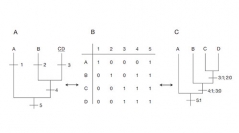

 Geodiversitas
28 (3) - Pages 409-420
Geodiversitas
28 (3) - Pages 409-420The data matrix can be generally viewed in three different ways for systematics and biogeography, which we refer to as phylo-phenetics, phylogenetic systematics (transformational) and Cladistic. Each views the matrix as a combination of manipulating points (taxa, areas and characters) and cells (character states), expressed in a table. All current methods, except Cladistics, treat the transformations or switches between cells and points as the basis for discovering and expressing relationships. We consider that Cladistics, however, treats a relationship between three cells, or points, as the smallest unit. We suggest that the difference between all three methods lies in the theory and application of the terms homologue and homology. It is shown that for most methods the data matrix is simply a phenetic device for optimising homologues rather than determining homologies and discovering relationships.
Cladistics, data matrix, homologues, homology, homoplasy, paralogy